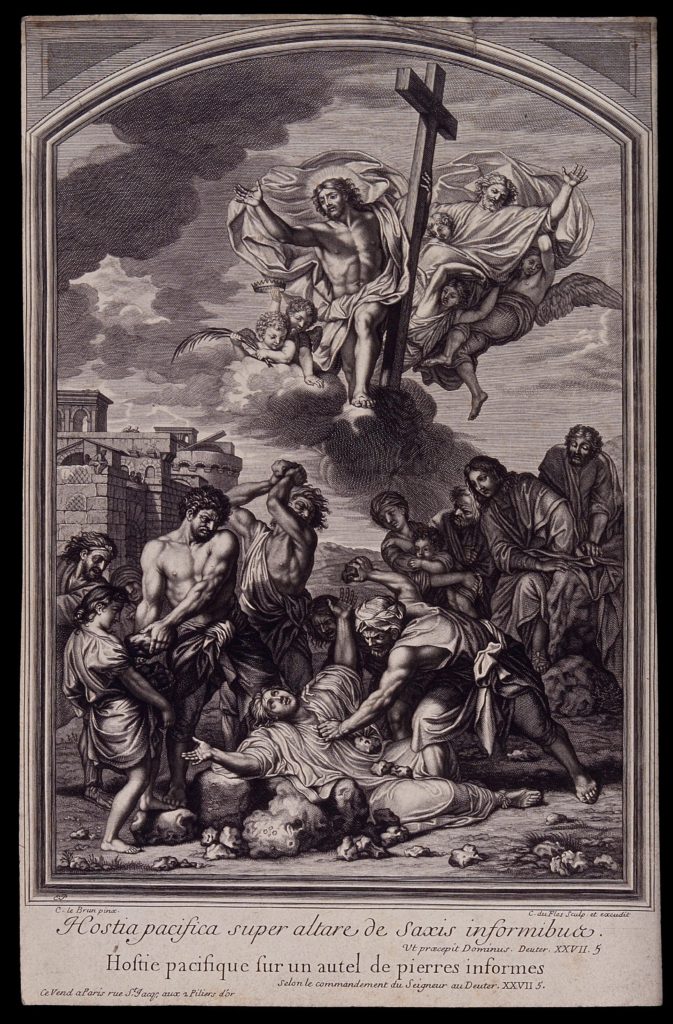The Crown of Martyrdom

St. Stephen stood out as the first among the seven deacons chosen to serve the Church. After a dispute broke out between the Hellenists and the Hebrews over how the widows were being neglected, the apostles chose seven men of good repute to serve the bodily needs of the poor so that they could remain dedicated to God’s Word and preaching.
Yet Stephen, beside assisting the apostles in this manner, would go on to preach and perform miraculous signs. The very next episode after the call of the deacons relates how St. Stephen was so full of the Spirit and of wisdom that the Jews, unable to reason against him, stirred up the crowds, called on false witnesses, and slandered him (Acts 6).
Once Stephen was before the high priest, he gave his famous sermon. Demonstrating his thorough understanding of the Scriptures, Stephen reveals that God’s people have had a track record of rejecting God’s prophets, and now they have betrayed and crucified his very Son. When they heard these things, the crowd was enraged, but Stephen looked up to heaven and saw Jesus at the right hand of God. While he was saying these things, the people “stopped their ears,” drove him out of the city, and stoned Stephen to death (Acts 7).
Thus Stephen became the first martyr for Christ. And as the first martyr, he beautifully took on his Lord’s own love and disposition toward his persecutors, saying, “receive my spirit,” and “Lord, do not hold this sin against them.”
And so Stephen, the protomartyr of the Christian faith, sets the template for all martyrs to come after him: that they would die in their Lord’s likeness even as Stephen himself did.
The Greek name Stephen translates to “crown,” which poetically takes on the imagery of his witness as told in The Golden Legend Vol. 1, “So Stephen is a crown because he is the first in martyrdom, a norm by example of his suffering and his way of life, a zealous speaker in his praiseworthy teaching of the widows.”
Brief history
While most martyrs are traditionally celebrated on the dates of their martyrdom, St. Stephen’s feast is not related to the date of his death, falling rather on the second day of Christmas. The reason for this is that the Church found it fitting that the feasts of those who were close to Jesus should also fall close to his own.
The Song of Solomon even reflects a bit of this thought when the Church, praising her Bridegroom, sings,
“My beloved is white and ruddy, the chiefest among ten thousand” Song of Solomon 5:10 (KJV).
Historically, “ruddy” has been seen to resemble St. Stephen, the protomartyr; “white,” John the Baptist whose feast falls on December 27th; and “ten thousand” for the Holy Innocents, commemorated on December 28th.
From a very early time, St. Stephen has been associated with horses. The connection here might not have any biblical basis, but Christmastide is traditionally a season of rest for work animals during which they are treated with special care. Out of this was born the famous St. Stephen Day sleigh ride: families would hitch up the horses and ride around the church three times in trinitarian fashion. It is a heart-warming tradition, even if it means spending some time outside in the cold.
December 26th is also known as Boxing Day – not after the sport, but because on this day the collection box of alms would be opened and distributed to the poor. This is also supposedly the origin of the piggy bank. Each family would save up their own almsgiving box – sometimes in the shape of a pig – to open on Boxing Day and give to those in need.
And of course, St. Stephen’s Day is the setting for the famous carol, “Good King Wenceslas” which tells of a king and a page traversing the weather to bring provisions for the poor,
In his master’s step he trod
Where the snow lay dinted
Heat was in the very sod
Which the Saint had printed
Therefore, Christian men, be sure
Wealth or rank possessing
Ye, who now will bless the poor
Shall yourselves find blessing.

Collect
Grant, O Lord, that in all our sufferings here upon earth for the testimony of Thy truth we may steadfastly look up to heaven and by faith behold the glory that shall be revealed: and, being filled with the Holy Ghost, may learn to love and bless our persecutors by the example of Thy first martyr, Saint Stephen; who prayed for his murderers to Thee, O blessed Jesus, who staidest at the right hand of God to succor all those that suffer for Thee, our only Mediator and Advocate; who livest and reignest with the Father and the Holy Ghost: ever one God, world without end. Amen.
Lessons
Resources
Issues, Etc. interview with the Rev. David Petersen on the Feast of St. Stephen
Propers found in Daily Divine Service Book: A Lutheran Daily Missal, edited by the Rev. Heath Curtis
References:
1. Weedon, William. Celebrating the Saints. Concordia Publishing House. 2016.
2. Voragine, Jacobus de. The Golden Legend: Reading on the Saints. Vol. 1. Translated by William Granger Ryan. Princeton Press. 1993.
Images:
1. Martyrdom of Saint Stephen, Charles Le Brun, France, ca. 1951.
2. The Martyrdom of St. Stephen, Annibale Carracci, Italy, c. 1603–1604.




[…] we discuss in our post about St. Stephen, the first martyr has famously been connected with horses—so much so that he is even the patron […]